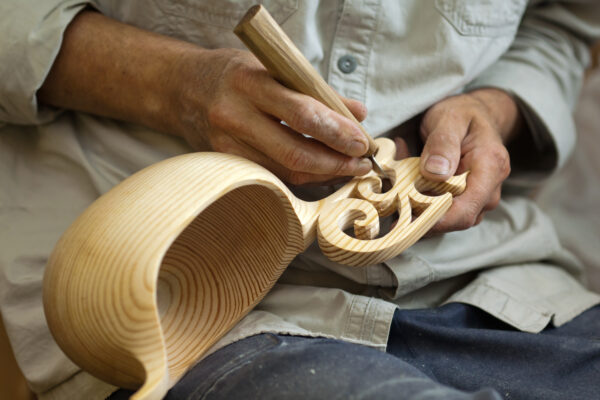
When I saw this cartoon horse on the internet last month, I fell in love with it! The next day, I finally decided to carve this horse. Since I am new to the carving field, carving cartoon horses is a process of exploration and learning for me.
The tools I use for carving are boxwood, saws, hand-carved knives, and a pneumatic engraver. I chose boxwood because it is hardwood with a tough, fine grain and a bright color. It is suitable for works with complex shapes and a sense of structure. Moreover, it is not easy to wear and tear in making and preserving, and it has a high collector’s value.
Now, I’m sharing my process for making it. If you’re interested, give it a try! You’ll make it!
Step 1
Sketch and keep tinkering with the manipulation until it’s pretty decent. I’ve got the sketch drawn and cut out, ready to trace onto the wood.

Step 2
Lightly sketch onto the wood with an inked line. Of course, you could just stick the paper on and just carve it. But that’s not what I’m used to.

Step 3
Use a saw to cut off the desired sections. Do you know? I have a little trick. I used to identify a few points on the edge of the pattern, then draw a reference line, and finally cut away the rough outline. Heh! This effectively cuts down on carving time. It’s best to cut outside the line because when you cut with a wire saw, it tends to be off. You find that the front side is cut along the line, however the other side may be cut inside the line.

Step 4
Then, I continued to paint details on this rough piece: the nose and ears.

Step 5
Now everything is ready! I started carving and sanding along the contours. Since the wood is so hard, you need an electric carving tool. If you’re using soft wood, you can just use a regular carving knife. But it takes longer. Softwoods I recommend are pine, ginkgo, camphor, etc. Their wood is soft and easier to carve. They are suitable for carving some simple patterns.

Step 6
Then, I started rounding off the body of the cartoon horse. Oh my goodness! This was a long process. Next came the carving details! This is when I must slow down and carefully carve those fine details. If I make a mistake, it could be all for naught!

Step 7
Sanding again. As I use an electric carving knife, its knife mark is relatively small, so only #400 sandpaper sanding once. If you are using a regular hand-carved knife, its cut marks are bigger, you need sandpaper between #180 and #240 for the first sanding. Caution! Tiny details like the eyes and ears of a cartoon horse should never be sanded with this sandpaper. Then sand the whole thing again with #400 sandpaper.

Each person has their own carving methods and habits, and each method is capable of achieving its purpose. I think the most important thing is more engraving and more practice. After all, practice makes perfect! I wish you all the success in the field!
Feature Image via Shutterstock



















When playing basket random, each match will last about 30 seconds, try to win against your opponent by throwing more balls into the basket.